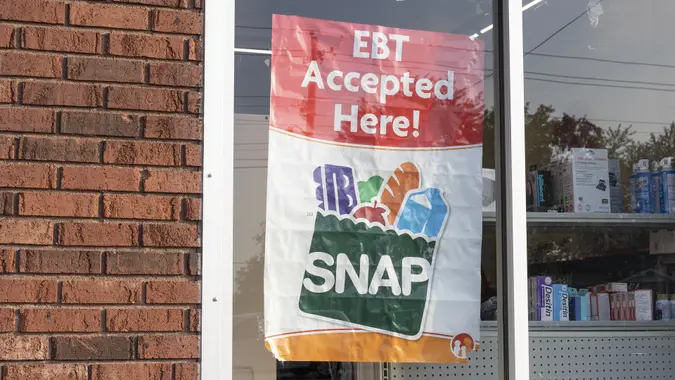How My 529 College Savings Plan Worked For Me

Commitment to Our Readers
GOBankingRates' editorial team is committed to bringing you unbiased reviews and information. We use data-driven methodologies to evaluate financial products and services - our reviews and ratings are not influenced by advertisers. You can read more about our editorial guidelines and our products and services review methodology.

20 Years
Helping You Live Richer

Reviewed
by Experts

Trusted by
Millions of Readers
If you don’t know what a 529 college savings plan is, and are planning to send your child to college, you’re going to want to read on. The 529 plan is a type of account that — for many Americans — is the best way to save for college. It’s especially crucial since the average cost of college tuition for private universities is creeping toward $40,000 a year, and public schools cost nearly $25,000 a year.
Patricia Roberts’ son recently graduated college, and Roberts says this was possible because she contributed to a 529 plan. “I am the proud mom of a recent debt-free college grad, having contributed a little at a time to a 529 college savings plan directly from my paycheck since my son was an infant,” Roberts said.
Roberts literally wrote the book on 529 plans, entitled “Route 529: A Parent’s Guide to Saving for College and Career Training with 529 Plans.” Here’s how a 529 plan works and how one helped Roberts send her son to college without racking up debt.
What Is a 529 College Savings Plan?
A 529 plan is a savings plan designed to help make it more affordable to save money for future education expenses. There are actually two types of 529 plans: prepaid tuition plans and college savings plans.
Nine states offer a 529 prepaid tuition plan wherein you can pay tuition now — locking in the present rate — and receive credits for future semesters at qualifying institutions.
The 529 college savings plan, however, is the more popular option and is offered in some form by all 50 states. In this case, you make contributions to an account that gives you certain tax advantages.
“Earnings on 529 plans grow tax-deferred and withdrawals can be made tax-free when used for a wide range of educational pursuits. As an additional tax benefit, 37 states and the District of Columbia offer an annual state tax credit or deduction for contributions to 529 college savings plans. Less tax can mean more money for college,” Roberts said.
How Does a 529 Savings Plan Work?
The 529 college savings plan is very similar to a Roth IRA in its structure in that you put after-tax income into the plan. Qualified withdrawals include education expenses for the account’s beneficiaries, which can include tuition, room and board, computers, books and — as of the most recent tax bill — some tuition for K-12 private schools. “529 plan withdrawals can also cover expenses associated with certain registered apprenticeships,” Roberts added.
Understanding 529 Taxes
One benefit for a 529 college savings plan over a Roth IRA is that there are no limitations on how much you can put into it in a given year, whereas a Roth IRA is capped at $6,500 annually. That means that you can find a tax-advantage home for a much larger amount of money using a 529 plan.
The one caveat, though, would be that you could potentially owe gift taxes if you exceed $17,000 into a single child’s 529 plan in a single year unless you use the special five-year forward gifting provision of Internal Revenue Code Section 529 which allows you (or others) to make a one-time gift equivalent to a maximum of up to five years of contributions to a 529 college savings account, or $85,000, provided no further gifts are made that would exceed the gifting limit during that five-year period.
Also, keep in mind each state’s 529 plan has its own maximum lifetime contribution limits per beneficiary – often between $300,000 to over 500,000 depending on plan.
What Else Do I Need To Know About Setting Up a 529 College Fund?
Even though the nuts and bolts of the different college savings plans are all relatively similar, it is worth noting that each state runs its own and differences between them could exist. What’s more, you might be able to shop around for better fee structures — and therefore hang on to more of your money — as some plans are open to people who live out of state. That said, some plans will also offer tax benefits or matching funds for investing in-state.
Withdrawal Limitations
You should also know that — much like your IRA — raiding a 529 plan for purposes other than what it’s intended for will cost you. If you make a withdrawal for something other than qualified education expenses, you’ll owe taxes on that money just like normal income, plus an additional 10% tax penalty.
If your circumstances change and you won’t need the 529 for its original beneficiary, Roberts says it’s very easy to pivot the plan. “If the original beneficiary on a 529 plan account does not need the funds for any form of higher education, the beneficiary can be changed by the account owner, with no tax consequences, to a member of the family of that beneficiary. This includes the beneficiary’s siblings, step-siblings, cousins, aunts, uncles, parents, grandparents and so on.”
“Since there is no time limit on use of 529 plan funds, they can also be saved for a later pursuit by the original beneficiary or used for the beneficiary’s future child(ren) some day,” Roberts added.
Who Qualifies for a 529 Plan?
Anyone can set up a 529 plan — you’ll just need your own information and that of the account’s beneficiary. “Initial minimums are often $25 or even less. Maximum account values can be up to $500,000 [or more], depending on the state plan chosen. The low minimums can be extremely helpful to those just getting started,” Roberts said.
One beneficiary can have multiple accounts set up for them, and one person can also own several accounts, so there’s flexibility that allows for parents, grandparents, aunts and uncles to all get in on the action if they’re so inclined.
“Unlike other forms of investments for higher education, most 529 college savings plans make it very easy to invite others to contribute to these accounts. After all, it can take a village to get a child to and through higher education, and even modest contributions from friends and extended family for birthdays, holidays and other milestones can be very helpful. Beyond this, employers can also contribute to employees’ 529 plan accounts as a financial wellness benefit,” Roberts said.
More From GOBankingRates
Joel Anderson contributed to the reporting for this article.
 Written by
Written by  Edited by
Edited by 

























